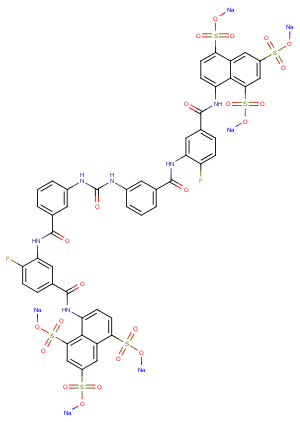Shopping Cart
- Remove All
 Your shopping cart is currently empty
Your shopping cart is currently empty

NF157 significantly decreases the expression of metalloproteinase (MMP)-3, MMP-13, which can be used in the treatment of osteoarthritis (OA). NF157 is a highly selective nanomolar P2Y11 antagonist (pKi: 7.35). The IC50s are 463 nM, 1811 μM, 170 μM for P2Y11 (Ki=44.3 nM), P2Y1 (Ki=187 μM), P2Y2 (Ki=28.9 μM), respectively.

| Pack Size | Price | Availability | Quantity |
|---|---|---|---|
| 5 mg | $584 | Backorder |
| Description | NF157 significantly decreases the expression of metalloproteinase (MMP)-3, MMP-13, which can be used in the treatment of osteoarthritis (OA). NF157 is a highly selective nanomolar P2Y11 antagonist (pKi: 7.35). The IC50s are 463 nM, 1811 µM, 170 µM for P2Y |
| Targets&IC50 | P2Y11:(ki)44.3 nM, P2Y11:(pki)7.35 , P2Y11:463 nM, P2Y2:170 μM, P2Y2:28.9 μM(ki), P2Y1:1811 μM, P2Y1:187 μM(ki) |
| In vitro | NF157 (30 and 60 μM; 24 hours) induces a significant reduction in the degradation of type II collagen in a dose-dependent manner. NF157 (30 and 60 μM; 24 hours) almost fully restores nuclear translocation of p65 triggered by TNF-α (10 ng/mL) and significantly reduces the luciferase activity of NF-κB. NF157 (60 μM) nearly fully rescues type II collagen from degradation induced by TNF-α (10 ng/mL). NF157 shows selectivity for P2Y11 over P2Y1 (>650-fold), P2Y2 (>650-fold), P2X2 (3-fold), P2X3 (8-fold), P2X4 (>22-fold), and P2X7 (>67-fold) but no selectivity over P2X1[1][2]. |
| Molecular Weight | 1437.1 |
| Formula | C49H28F2N6Na6O23S6 |
| Cas No. | 104869-26-3 |
| Relative Density. | no data available |
| Storage | Powder: -20°C for 3 years | In solvent: -80°C for 1 year | Shipping with blue ice. |

Copyright © 2015-2025 TargetMol Chemicals Inc. All Rights Reserved.